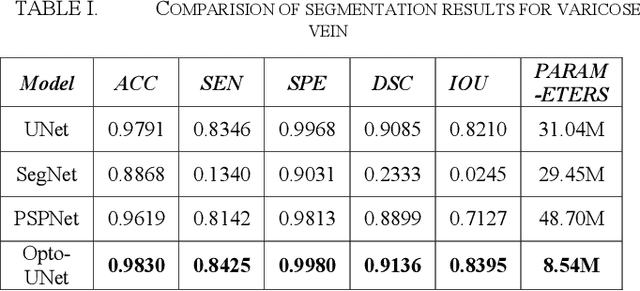Maryam Viqar
WAVE-UNET: Wavelength based Image Reconstruction method using attention UNET for OCT images
Oct 05, 2024Abstract:In this work, we propose to leverage a deep-learning (DL) based reconstruction framework for high quality Swept-Source Optical Coherence Tomography (SS-OCT) images, by incorporating wavelength ({\lambda}) space interferometric fringes. Generally, the SS-OCT captured fringe is linear in wavelength space and if Inverse Discrete Fourier Transform (IDFT) is applied to extract depth-resolved spectral information, the resultant images are blurred due to the broadened Point Spread Function (PSF). Thus, the recorded wavelength space fringe is to be scaled to uniform grid in wavenumber (k) space using k-linearization and calibration involving interpolations which may result in loss of information along with increased system complexity. Another challenge in OCT is the speckle noise, inherent in the low coherence interferometry-based systems. Hence, we propose a systematic design methodology WAVE-UNET to reconstruct the high-quality OCT images directly from the {\lambda}-space to reduce the complexity. The novel design paradigm surpasses the linearization procedures and uses DL to enhance the realism and quality of raw {\lambda}-space scans. This framework uses modified UNET having attention gating and residual connections, with IDFT processed {\lambda}-space fringes as the input. The method consistently outperforms the traditional OCT system by generating good-quality B-scans with highly reduced time-complexity.
Modified watershed approach for segmentation of complex optical coherence tomographic images
Mar 29, 2023Abstract:Watershed segmentation method has been used in various applications. But many a times, due to its over-segmentation attributes, it underperforms in several tasks where noise is a dominant source. In this study, Optical Coherence Tomography images have been acquired, and segmentation has been performed to analyse the different regions of fluid filled sacs in a lemon. A modified watershed algorithm has been proposed which gives promising results for segmentation of internal lemon structures.
Opto-UNet: Optimized UNet for Segmentation of Varicose Veins in Optical Coherence Tomography
Mar 20, 2023



Abstract:Human veins are important for carrying the blood from the body-parts to the heart. The improper functioning of the human veins may arise from several venous diseases. Varicose vein is one such disease wherein back flow of blood can occur, often resulting in increased venous pressure or restricted blood flow due to changes in the structure of vein. To examine the functional characteristics of the varicose vein, it is crucial to study the physical and bio mechanical properties of the vein. This work proposes a segmentation model Opto-UNet, for segmenting the venous wall structure. Optical Coherence Tomography system is used to acquire images of varicose vein. As the extracted vein is not uniform in shape, hence adequate method of segmentation is required to segment the venous wall. Opto-UNet model is based on the U-Net architecture wherein a new block is integrated into the architecture, employing atrous and separable convolution to extract spatially wide-range and separable features maps for attaining advanced performance. Furthermore, the depth wise separable convolution significantly reduces the complexity of the network by optimizing the number of parameters. The model achieves accuracy of 0.9830, sensitivity of 0.8425 and specificity of 0.9980 using 8.54 million number of parameters. These results indicate that model is highly adequate in segmenting the varicose vein wall without deteriorating the segmentation quality along with reduced complexity
Frequency-domain Blind Quality Assessment of Blurred and Blocking-artefact Images using Gaussian Process Regression model
Mar 05, 2023



Abstract:Most of the standard image and video codecs are block-based and depending upon the compression ratio the compressed images/videos suffer from different distortions. At low ratios, blurriness is observed and as compression increases blocking artifacts occur. Generally, in order to reduce blockiness, images are low-pass filtered which leads to more blurriness. Also, in bokeh mode images they are commonly seen: blurriness as a result of intentional blurred background while blocking artifact and global blurriness arising due to compression. Therefore, such visual media suffer from both blockiness and blurriness distortions. Along with this, noise is also commonly encountered distortion. Most of the existing works on quality assessment quantify these distortions individually. This paper proposes a methodology to blindly measure overall quality of an image suffering from these distortions, individually as well as jointly. This is achieved by considering the sum of absolute values of low and high-frequency Discrete Frequency Transform (DFT) coefficients defined as sum magnitudes. The number of blocks lying in specific ranges of sum magnitudes including zero-valued AC coefficients and mean of 100 maximum and 100 minimum values of these sum magnitudes are used as feature vectors. These features are then fed to the Machine Learning (ML) based Gaussian Process Regression (GPR) model, which quantifies the image quality. The simulation results show that the proposed method can estimate the quality of images distorted with the blockiness, blurriness, noise and their combinations. It is relatively fast compared to many state-of-art methods, and therefore is suitable for real-time quality monitoring applications.
Deep Learning based Segmentation of Optical Coherence Tomographic Images of Human Saphenous Varicose Vein
Mar 02, 2023Abstract:Deep-learning based segmentation model is proposed for Optical Coherence Tomography images of human varicose vein based on the U-Net model employing atrous convolution with residual blocks, which gives an accuracy of 0.9932.
 Add to Chrome
Add to Chrome Add to Firefox
Add to Firefox Add to Edge
Add to Edge